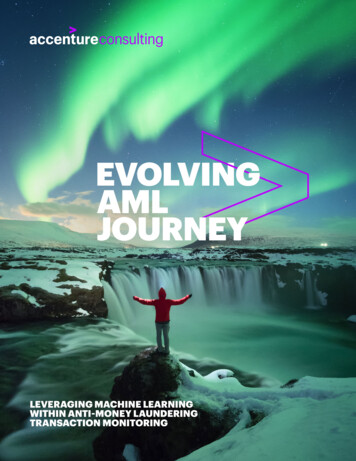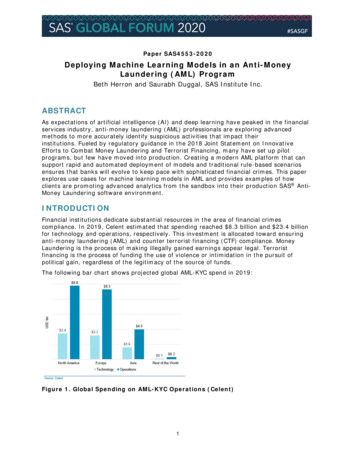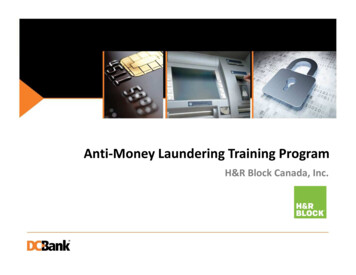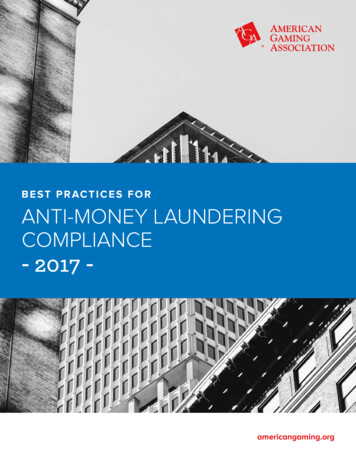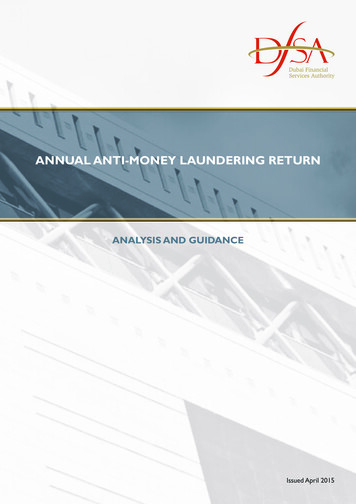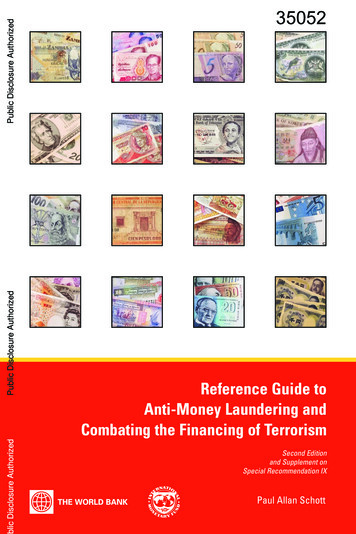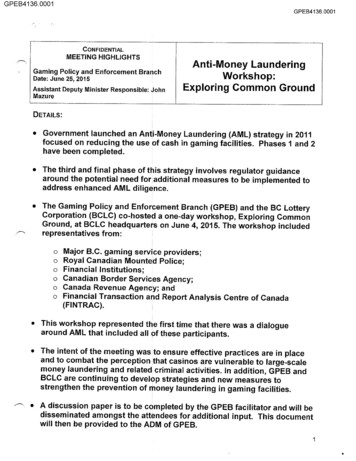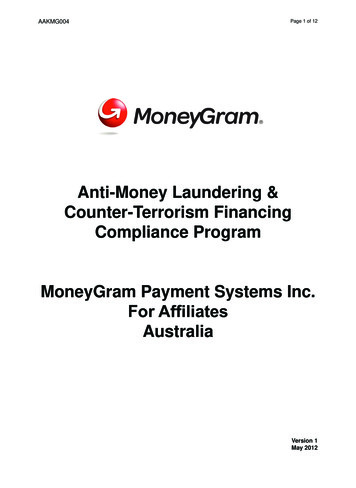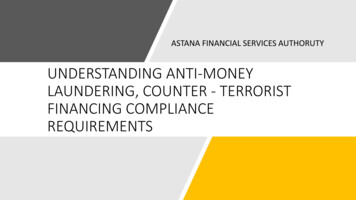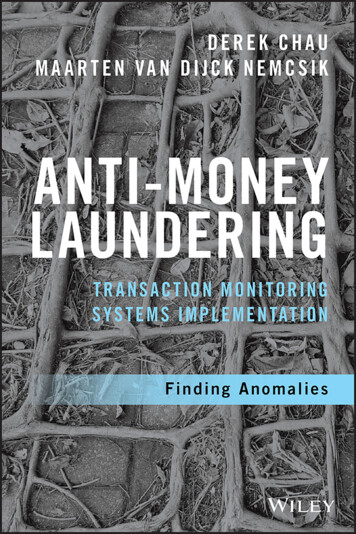
Transcription
Anti-Money LaunderingTransactionMonitoring SystemsImplementation
Wiley and SASBusiness SeriesThe Wiley and SAS Business Series presents books that help seniorlevel managers with their critical management decisions.Titles in the Wiley and SAS Business Series include:Analytics: The Agile Way by Phil SimonThe Analytic Hospitality Executive by Kelly A. McGuireThe Analytics Lifecycle Toolkit: A Practical Guide for an Effective AnalyticsCapability by Gregory S. NelsonAnalytics in a Big Data World: The Essential Guide to Data Science and ItsApplications by Bart BaesensA Practical Guide to Analytics for Governments: Using Big Data for Goodby Marie LowmanBank Fraud: Using Technology to Combat Losses by Revathi SubramanianBig Data Analytics: Turning Big Data into Big Money by Frank OhlhorstBig Data, Big Innovation: Enabling Competitive Differentiation throughBusiness Analytics by Evan StubbsBusiness Analytics for Customer Intelligence by Gert LaursenBusiness Intelligence Applied: Implementing an Effective Information andCommunications Technology Infrastructure by Michael GendronBusiness Intelligence and the Cloud: Strategic Implementation Guide byMichael S. GendronBusiness Transformation: A Roadmap for Maximizing OrganizationalInsights by Aiman ZeidThe Cloud-Based Demand-Driven Supply Chain by Vinit SharmaConnecting Organizational Silos: Taking Knowledge Flow Management tothe Next Level with Social Media by Frank LeistnerData-Driven Healthcare: How Analytics and BI Are Transforming theIndustry by Laura MadsenDelivering Business Analytics: Practical Guidelines for Best Practice byEvan StubbsDemand-Driven Forecasting: A Structured Approach to Forecasting (Second Edition) by Charles Chase
Demand-Driven Inventory Optimization and Replenishment: Creating aMore Efficient Supply Chain by Robert A. DavisDeveloping Human Capital: Using Analytics to Plan and Optimize YourLearning and Development Investments by Gene Pease, Barbara Beresford, and Lew WalkerThe Executive’s Guide to Enterprise Social Media Strategy: How SocialNetworks Are Radically Transforming Your Business by David Thomasand Mike BarlowEconomic and Business Forecasting: Analyzing and Interpreting Econometric Results by John Silvia, Azhar Iqbal, Kaylyn Swankoski, SarahWatt, and Sam BullardEconomic Modeling in the Post Great Recession Era: Incomplete Data,Imperfect Markets by John Silvia, Azhar Iqbal, and Sarah Watt HouseEnhance Oil & Gas Exploration with Data-Driven Geophysical and Petrophysical Models by Keith Holdaway and Duncan IrvingForeign Currency Financial Reporting from Euros to Yen to Yuan: A Guideto Fundamental Concepts and Practical Applications by Robert RowanHarness Oil and Gas Big Data with Analytics: Optimize Exploration andProduction with Data Driven Models by Keith HoldawayHealth Analytics: Gaining the Insights to Transform Health Care byJason BurkeHeuristics in Analytics: A Practical Perspective of What Influences OurAnalytical World by Carlos Andre Reis Pinheiro and Fiona McNeillHuman Capital Analytics: How to Harness the Potential of Your Organization’s Greatest Asset by Gene Pease, Boyce Byerly, and Jac Fitz-enzImplement, Improve and Expand Your Statewide Longitudinal Data System: Creating a Culture of Data in Education by Jamie McQuiggan andArmistead SappIntelligent Credit Scoring: Building and Implementing Better Credit RiskScorecards (Second Edition) by Naeem SiddiqiJMP Connections: The Art of Utilizing Connections in Your Data by JohnWubbelKiller Analytics: Top 20 Metrics Missing from Your Balance Sheet byMark BrownMachine Learning for Marketers: Hold the Math by Jim Sterne
On-Camera Coach: Tools and Techniques for Business Professionals in aVideo-Driven World by Karin ReedPredictive Analytics for Human Resources by Jac Fitz-enz and JohnMattox IIPredictive Business Analytics: Forward-Looking Capabilities to ImproveBusiness Performance by Lawrence Maisel and Gary CokinsProfit-Driven Business Analytics: A Practitioner’s Guide to TransformingBig Data into Added Value by Wouter Verbeke, Cristian Bravo, andBart BaesensProfit from Your Forecasting Software: A Best Practice Guide for SalesForecasters by Paul GoodwinProject Finance for Business Development by John E. TriantisRetail Analytics: The Secret Weapon by Emmett CoxSocial Network Analysis in Telecommunications by Carlos Andre ReisPinheiroStatistical Thinking: Improving Business Performance (Second Edition)by Roger W. Hoerl and Ronald D. SneeStrategies in Biomedical Data Science: Driving Force for Innovation byJay EtchingsStyle & Statistic: The Art of Retail Analytics by Brittany BullardTaming the Big Data Tidal Wave: Finding Opportunities in Huge DataStreams with Advanced Analytics by Bill FranksToo Big to Ignore: The Business Case for Big Data by Phil SimonThe Value of Business Analytics: Identifying the Path to Profitability byEvan StubbsThe Visual Organization: Data Visualization, Big Data, and the Quest forBetter Decisions by Phil SimonTransforming Healthcare Analytics: The Quest for Healthy Intelligence byMichael N. Lewis and Tho H. NguyenUsing Big Data Analytics: Turning Big Data into Big Money by Jared DeanWin with Advanced Business Analytics: Creating Business Value fromYour Data by Jean Paul Isson and Jesse HarriottFor more information on any of the above titles, please visit www.wiley.com.
plementationFinding AnomaliesDerek ChauMaarten van Dijck Nemcsik
Copyright 2021 by SAS Institute Inc. All rights reserved.Published by John Wiley & Sons, Inc., Hoboken, New Jersey.Published simultaneously in Canada.No part of this publication may be reproduced, stored in a retrieval system, ortransmitted in any form or by any means, electronic, mechanical, photocopying,recording, scanning, or otherwise, except as permitted under Section 107 or 108 ofthe 1976 United States Copyright Act, without either the prior written permission ofthe Publisher, or authorization through payment of the appropriate per-copy fee tothe Copyright Clearance Center, Inc., 222 Rosewood Drive, Danvers, MA 01923, (978)750-8400, fax (978) 646-8600, or on the Web at www.copyright.com. Requests to thePublisher for permission should be addressed to the Permissions Department, JohnWiley & Sons, Inc., 111 River Street, Hoboken, NJ 07030, (201) 748-6011, fax (201)748-6008, or online at www.wiley.com/go/permissions.Limit of Liability/Disclaimer of Warranty: While the publisher and author have usedtheir best efforts in preparing this book, they make no representations or warrantieswith respect to the accuracy or completeness of the contents of this book and specificallydisclaim any implied warranties of merchantability or fitness for a particular purpose. Nowarranty may be created or extended by sales representatives or written sales materials.The advice and strategies contained herein may not be suitable for your situation. Youshould consult with a professional where appropriate. Neither the publisher nor authorshall be liable for any loss of profit or any other commercial damages, including but notlimited to special, incidental, consequential, or other damages.For general information on our other products and services or for technical support,please contact our Customer Care Department within the United States at (800) 7622974, outside the United States at (317) 572-3993, or fax (317) 572-4002.Wiley publishes in a variety of print and electronic formats and by print-on-demand.Some material included with standard print versions of this book may not be includedin e-books or in print-on-demand. If this book refers to media such as a CD or DVDthat is not included in the version you purchased, you may download this material athttp://booksupport.wiley.com. For more information about Wiley products, visit www.wiley.com.Library of Congress Cataloging-in-Publication DataNames: Yip, Derek Chau Chan, 1978- author. Nemcsik, Maarten van Dijck,1972- author.Title: Anti-money laundering transaction monitoring systems implementation: finding anomalies / Derek Chau Chan Yip, Maarten van Dijck Nemcsik.Description: First Edition. Hoboken : Wiley, 2020. Series: Wiley andSAS business series Includes index.Identifiers: LCCN 2020032916 (print) LCCN 2020032917 (ebook) ISBN9781119381808 (cloth) ISBN 9781119381969 (adobe pdf) ISBN9781119381938 (epub)Subjects: LCSH: Money laundering—Prevention.Classification: LCC HV8079.M64 Y57 2020 (print) LCC HV8079.M64 (ebook) DDC 363.25/968—dc23LC record available at https://lccn.loc.gov/2020032916LC ebook record available at https://lccn.loc.gov/2020032917Cover image: Derek ChauCover design: Wiley10 9 8 7 6 5 4 3 2 1
ContentsAbout the AuthorsxiiiAcknowledgmentsxvPrefacexviiChapter 1An Introduction to Anti-Money Laundering 1The Emergence of AML 2AML as a Compliance Domain 5The Objectives of AML 9Regulatory Reporting 9Corporate Citizenship versus Profitability 10About True and False Positives and Negatives 11The Evolution of Automated Transaction Monitoring 15From Rule-Based to Risk-Based 17From Static to More Dynamic TransactionMonitoring 22Latest Trends: Machine Learning and ArtificialIntelligence 26Latest Trends: Blockchain 29Risk-Based Granularity and Statistical Relevance 34Summary 36Chapter 2Transaction Monitoring in Different BusinessesBanking 43Correspondent Banking 46Banking – Trade Finance 49Banking – Credit Card 60Insurance 60Securities 63Stored Value Facilities (SVFs) 66Casinos and Online Gambling 68Lottery and Jockey Club 70vii39
viiiContentsOther Businesses 72Summary 72Chapter 3The Importance of Data 75ETL: Extract, Transform, and Load 76Extract: Data Availability and Sourcing 77Transform: Data Quality, Conversion, and RepairData Load and Further Processing 89Loading of the Data 89Data Lineage 92Multiple ETLs 92Summary 93Chapter 4Typical Scenario Elements 95Transaction Types 96Actionable Entity 100Scenario Parameters 106Use of Maximum Instead of Minimum ValueThreshold 108Threshold per Customer 109Pre-Computing Data 110Timeliness of Alerts 112Use of Ratios 114Ratio as Degree of Change/Similarity 117Ratio as Proportion 119Other Common Issues 120Chapter 5Scenarios in Detail 121Large Aggregate Value 122Unexpected Transaction 123High Velocity/Turnover 129Turnaround/Round-Tripping 132Structuring 136Early Termination/Quick Reciprocal Action 141Watchlist 141Common Specifications across Unrelated Entities80142
ContentsInvolving Unrelated Third Party 144One-to-Many 144Transacting Just below Reporting Threshold145Chapter 6The Selection of Scenarios 147Selecting Scenarios 148Regulatory Requirements 148Business Drivers 150Data Quality and Availability of Reference Data 152Maintenance of the Scenario Repository 152How Specific should a Scenario Rule Be? 153Overlapping Scenario Rules 155Summary 156Chapter 7Entity Resolution and Watchlist MatchingEntity Resolution 158Watchlists 161Summary 184Chapter 8Customer Segmentation 185The Need for Segmenting Customers 186Approaches to Segmentation 188Overview of Segmentation Steps 191Organizational Profiling 193Common Segmentation Dimensions 195Considerations in Defining Segments 197Check Source Data for Segmentation 199Verify with Statistical Analysis 200Ongoing Monitoring 205Change of Segmentation 205Summary 207Chapter 9Scenario Threshold Tuning 209The Need for Tuning 210Parameters and Thresholds 210True versus False, Positive versus NegativeCost 213157212vii
xContentsAdapting to the Environment 214Relatively Simple Ways to Tune Thresholds 215Objective of Scenario Threshold Tuning 216Increasing Alert Productivity 216Definition of a Productive Alert 219Use of Thresholds in Different Kinds of ScenarioRules 220Regulation-Driven Rules 220Statistical Outlier 221Insignificance Threshold 225Safety-Blanket Rules 225Combining Parameters 226Steps for Threshold Tuning 228Preparation of Analysis Data 234Scope of Data 234Data Columns 234Quick and Easy Approach 237Analysis of Dates 238Stratified Sampling 239Statistical Analysis of Each Tunable Scenario ThresholdVariable 239Population Distribution Table by Percentile (RankingAnalysis) 244Distribution Diagram Compressed as a Single Line 245Multiple Peaks 246Zeros 246Above-the-Line Analysis and Below-the-Line Analysis 247Above-the-Line Analysis 247Below-the-Line Analysis 249Use of Scatter plots and Interactions betweenParameter Variables 251Binary Search 258What-If Tests and Mock Investigation 260What-If Tests 260
ContentsSample Comparisons of What-If Tests 261Qualifying Results of What-If Tests 262Scenario Review Report 263Scenario Review Approach 268Scenario Review Results 268Summary 274Index277ix
About the AuthorsChau Chan Yip (Derek), is a principal consultant in SAS Hong Kong.He has twenty years of IT system integration and implementationexperience. He has participated in several complex and large-scale projects. He leads the SAS AML consulting team in Hong Kong overseeingthe delivery and support of over 30 SAS AML sites. Derek designed atool for analyzing and tuning transaction monitoring scenario thresholds. This tool was deployed in six financial institutes in Hong Kong,and he led the team in providing scenario review service recommending the thresholds, customer segmentation, and other adjustments tothe AML transaction monitoring systems. He has also held advisoryroles for some foreign delivery of this AML solution. Derek has anhonors bachelor degree in computer science and computer engineering from the Hong Kong University of Science and Technology, and amaster of science degree in computer science from the Chinese University of Hong Kong.Maarten van Dijck Nemcsik, LLM, PhD, has worked for SAS since2012 as a financial crimes and (tax) compliance domain expert andsolution lead. Over the years he has implemented SAS AML, Customer Due Diligence, Enterprise Case Management, and SAS VisualInvestigator. Maarten is currently part of the SAS Global Fraud &Security Business Intelligence Unit, being responsible for internal andexternal training courses for the implementation of the SAS financialcrimes and compliance products and project implementation advisoryand support. After obtaining a master’s and PhD degree in the fieldof criminal law and procedure and working as a post doctorate in thefield of Organized Crime research at the University of Tilburg, theNetherlands, Maarten worked as a security fraud intelligence officerfor ABN AMRO Bank NV in Amsterdam and The Royal Bank of Scotland Group in London. Maarten has published in the field of organizedand economic crime, anti-money laundering, and compliance in thediamond sector.xiii
PrefaceOver the past years, we have been supporting quite a significant number of AML and other financial crime-related implementation projects. We have been meeting with many customer project teams andend users, mainly across Asia Pacific, Europe, and the Middle East.From working with small financial institutions that operate strictly ata domestic level, to implementing our software in some of the largestfinancial groups worldwide . . . and almost everything in between. Aseach customer is different, so is each project and we have had to findsolutions for a wide range of, sometimes peculiar, customer requirements. We are thankful to our customers for coming up with sucha wide range of wishes and demands, as it challenges us not only asconsultants but also as software developers, to continuously improveour software, but also our personal skills and our way of deliveringtailor-made solutions to satisfaction.SAS has a relatively low attrition rate, which is testament toSAS being one of the best employers worldwide (don’t take ourword for it, Google it!). But even then, as time passes, we see teammembers come and go and may ourselves move on to explore different pastures. With each skillful consultant that moves on in theircareer path, insights, expertise, and experience is bound to get lost.Back in 2016, Derek began thinking about preserving these insights,knowledge, and experience via writing and publishing. This initiative was well received within SAS, and a foundation was laid for thisbook . . . Derek’s first one.This was initially an individual effort, and not an easy task for a“technical” guy who, until now was happy conversing within his owncomfort zone . . . the language of data and computers! After a whileMaarten joined Derek and we have been working on the book eversince, in whatever time we could spare from both our busy jobs and,more importantly, family life.Even at the time when social distancing wasn’t even “a thing,”we kept well apart from each other. Maarten working from Spainxvii
xviiiP r e fac eand Derek from Hong Kong. Never on a project together, or even atraining. As technically savvy as we believe ourselves to be, (why elsewould we work in this field and for a company like SAS!) we werefine communicating strictly through electronic means. The time zonedifference only became a bit of a hindrance when our SAS editorialsupport, namely Lauree Shepard, was based at the SAS mothership inCary, North Carolina.So, this book is about transaction monitoring implementation,which is, at the end of the day, inescapably a technical subject. In theworld of today, technology is still very much in the fast lane. Fouryears have elapsed since 2016 and during the process we were worried about some of the content becoming outdated. That worry hasstill not dissipated entirely, but we are modestly confident that mostof the information and guidance that we set out to share will still berelevant for those entering the field of AML software implementation.We hope that most of our insights as captured in the following chapters will hold some truth for now and in the foreseeable future. Andwe would like to thank you, as our (aspirant) reader . . . for placingyour trust in us and this book.
C H A P T E R1An Introductionto Anti-MoneyLaundering1
2ANTI-MONEY LAUNDERINGTHE EMERGENCE OF AMLMoney laundering is generally understood as the concealment of anillegitimate source of assets, providing an apparent legal origin. Peoplehave various reasons to whitewash assets: they might want to concealthe original crime and not let their wealth become a whistleblower, orthey may simply want to build up a reputation of being a successful andrespectable member of the community. Since the late 1980s, there hasbeen another reason to launder money. Law enforcement, initially aspart of the US-driven war on drugs, started to clamp down on the financial aspect of crime and new laws were enacted globally to criminalizethe laundering of assets itself, whilst at the same time making it mucheasier for law enforcement to seize assets and for the courts to includeconfiscation of assets, both as a penalty and a measure of redistributivejustice. Against the backdrop of a publicly perceived rise in profit-drivencrime, it was generally felt that criminals should be hit where it hurt themost: in their pockets. Criminalization of the act of money launderingand the emphasis on the law enforcement effort to go after the moneyare a natural extension of the age-old adage that no man should profitfrom his own crime. Consequently, money laundering touched uponthe core beliefs about a just society, where advancing oneself by evadingthe rules is felt as unfair towards those citizens who abide by the law. Assuch, money laundering (as any criminal offence) is a crime against society, against the public . . . and there is a public duty to fight and prevent.By the late 1990s, another dimension was added: the counteracting of the financing of terrorism, and this was further fueled by theUS terrorist attacks on September 11, 2001. This dimension workedas a catalyst for the development of ever more stringent anti-moneylaundering regulations, adopted across the globe, and the emergenceof what arguably can be called an entire new industry: Compliance. Toa large degree, Compliance became a synonym for AML Compliance,AML standing for Anti-Money Laundering (and we will use this wellestablished acronym throughout the rest of this book), but even thatis a pars pro toto, as it commonly also encompasses counter-terroristfinancing (CTF).There were two main factors that contributed to the emergenceof AML Compliance. First, there is the down-to-earth fact that law
A n I ntrodu c tion to A nti - M oney L aundering3enforcement simply did not and does not have the capability or thecapacity to do what is needed to detect money laundering. This iswhy financial institutions were recruited to partake in law enforcement as gatekeepers. Second, there was the shift in public perception about the role of private companies as Corporate Citizens andthe intrinsic notion of good citizenship, linked to widespread notionson corporate moral responsibility, sustainability, and good standingand reputation. This is why the financial institutions, to date, acceptthe operational and cost burden of AML. Obviously, there is a clearfinancial incentive for financial institutions to be compliant: thefines imposed by the regulatory watchdogs for non-compliance areenormous. But beneath this mundane motivator there seems to bea genuine acceptance by the financial industry of the role they haveto play, as members of society at large, to disallow and prevent theabuse of their systems.Accepting this role is one thing, it is quite another to live up to it.Being a money laundering prevention gatekeeper imposes all kind ofpractices that need to be established in order to keep compliant withall regulatory requirements. There is the practice of “know your customer” (KYC), which in a nutshell means establishing that a customeris who he claims to be. Then there is the practice of enhanced due diligence: risk assessing a financial institution’s entire customer base ona continuous basis, specifically for the purpose of AML and CTF, andstepping up the monitoring effort or even reconsidering the relationship with the client in the case of high risk. Lastly, there is the practiceof transaction monitoring: looking at behavior on the account to identify any suspicious1 or unusual activity. When such activity is deemedto be found and cannot be refuted by further analysis or investigation,then the financial institution has the obligation to report this to thelocal Financial Intelligence Unit, which in most countries acts as theWhilst some jurisdictions allow for financial institutions to look for suspicious activities,other countries define this as an activity specifically for law enforcement and againstthe rule of law to task the banking sector with law enforcement tasks typically associated with the public domain. Whereas the semantic distinction between suspicious andunusual seem to point in the direction of the former compared to the latter, requiring agreater investigation effort by the financial institution, in reality, there does not seem tobe much difference other than in the wording.1
4ANTI-MONEY LAUNDERINGconduit between the financial institutions and law enforcement, andquite often acts in an investigative capacity itself.It goes without saying that complying with AML along the linesof these three practices impose a huge administrative burden on thefinancial institutions, requiring significant investment in front, middle, and back office operations. This applies in particular to transactionmonitoring where volumes of customers, accounts, and transactionsare significant, and meaningful analysis cannot be done by humanlabor alone.And this is where AML software enters the scene. Financial institutions not only deploy electronic means to detect suspicious or unusual activity because of the sheer scale of the data, but also becauseregulatory watchdogs require them to apply computerized forms ofanalysis to avoid inconsistency and too much reliance on the (frailtyof) human capacity to do so. Whilst computer systems carry out thetasks they can do more efficiently than humans, there is still a role forhuman analysts and investigators to further verify the validity of theinitial electronic analysis. Thus AML transaction monitoring is typically divided into three practices: electronic analysis of transactionsand the subsequent generation of alerts, the assessment by a humananalyst with regard to the validity of the alert(s), and the subsequentfiling of a regulatory report if one or more related alerts cannot berefuted as false positives.The end-to-end process of data collection involves electronic andthen human analysis; further investigation of more complex cases;and reporting to the regulators and being able to explain to the regulator how risks have been assessed and mitigated appropriately. All ofthis constitutes a complex operation, driving up the (manufacturing)cost of financial services delivery and potentially upsetting customers,especially when these customers find themselves unjustifiably subjectto a financial investigation, often with the added penalty of not beingable to execute transactions and do business. Striking the balancebetween satisfying both the regulator (compliance), banking customers (services delivery), and shareholders (keeping operational costsdown whilst maintaining a good reputation) is of utmost importancefor financial institutions today. It is the AML transaction monitoringsoftware that enables financial institutions to do this.
A n I ntrodu c tion to A nti - M oney L aundering5The aim of this book is to explain various aspects of AML transaction monitoring software and will mainly focus on the electronicanalysis, both from a perspective of the logic applied in this analysisand the challenges faced during implementation of that software interms of data integration and other technical aspects.We, as authors of this book, share a history with SAS, representinga combined 17 years of experience in the implementation, configuration, and redesign of the SAS Compliance Software. SAS has beenconsidered market leader in a number of significant areas relevant forthe practice of AML: data integration, analytics, transaction monitoring, case analysis, and reporting.For any AML software to be taken seriously, is by definition complex. This is because AML transaction monitoring is a multifacetedprocess. This book aims to provide further clarity mainly on the logicapplied to the rules. We hope to provide a good starting point for thebeginning AML scenario analyst and administrator. We also hope thiswill benefit AML alert analysts and investigators, so that they mayunderstand a bit better the output of what we call the alerting enginein terms of the AML and CTF alerts. To that aim this book will put thetechnical and analytical detail in its business context.One could legitimately ask if this would not play into the hands ofthose whose actions we try to detect and allow them to improve theirability to evade detection. We think this not to be the case. Whilstmuch of the rule-based approach is already in the public domain, thekeys are in the actual thresholds financial institutions set as part ofthese rules for their specific customer segments.AML AS A COMPLIANCE DOMAINMoney laundering is commonly defined as the act of providing a seemingly legitimate source for illegitimate funds. In order to conceal theillegitimate origin, the proceeds of economic crimes need to be whitewashed. This will do two things for the criminal beneficiary. Firstly, itwill cut the follow-the-money trail leading to the criminal acts, thusavoiding financial assets giveaways of the underlying crimes. But, secondly, even when it does and the criminal is successfully prosecutedand convicted for the criminal proceeds, when successfully laundered,
6ANTI-MONEY LAUNDERINGthe proceeds will not be subject to confiscation, since no link betweenthese assets and the convicted can be proven. Even if the criminal isimprisoned, the criminal or their family will still be able to dispose ofthe assets and wealth build from a criminal life.Anti-Money Laundering, therefore, is, in its widest sense, a worldwide framework of legislation and regulations to prevent abuse of thefinancial system for the purpose of money laundering, and the practices and processes to comply with this framework. AML attempts toput in barriers to prevent abuse of the financial system by those seeking to conceal the criminal origins of assets and/or the link to their(criminal) ultimate beneficial owners.What the legislation and regulations have in common is thatthey require private sector organizations, defined as Financial ServiceProviders, to put in place a mechanism to prevent the abuse of thefinancial system by perpetrators of financial crimes. Underpinning thiseffort is the adage that criminals should not be allowed to profit fromtheir (economic) crimes and respectable financial service providersshould not facilitate criminals in doing so. Some hold the view thatAML regulations seek to recruit the financial service providers in theactive detection of economic crime through the detection of moneylaundering that is often associated with it.Compliance and AML cover a wide domain that includes manysubdomains, such as customer acceptance (KYC, name screening),customer due diligence, handling of politically exposed persons,ongoing risk assessment, real-time screening on remittance, transaction monitoring, sanctions screening, regulatory reporting, and more.Although there are tools and technologies available for each and all ofthose aspects, of equal importance is the awareness and understanding of the institutes’ personnel about AML principles and regulationsand how to apply these in everyday practice. The software is thereto assist responsible staff to efficiently and effectively work throughthe vast amount of customer transaction data, sanctions, and watchlists, and to detect links and patterns that are impossible to see with ahuman-driven and/or naked eye approach.Within the various subdomains, transaction monitoring oftenincurs the
The Emergence of AML 2 AML as a Compliance Domain 5 The Objectives of AML 9 Regulatory Reporting 9 Corporate Citizenship versus Profitability 10 About True and False Positives and Negatives 11 The Evolution of Automated Transaction Monitoring 15 From Rule-Based to Risk-Based 17 From Static to More Dynamic Transaction Monitoring 22
